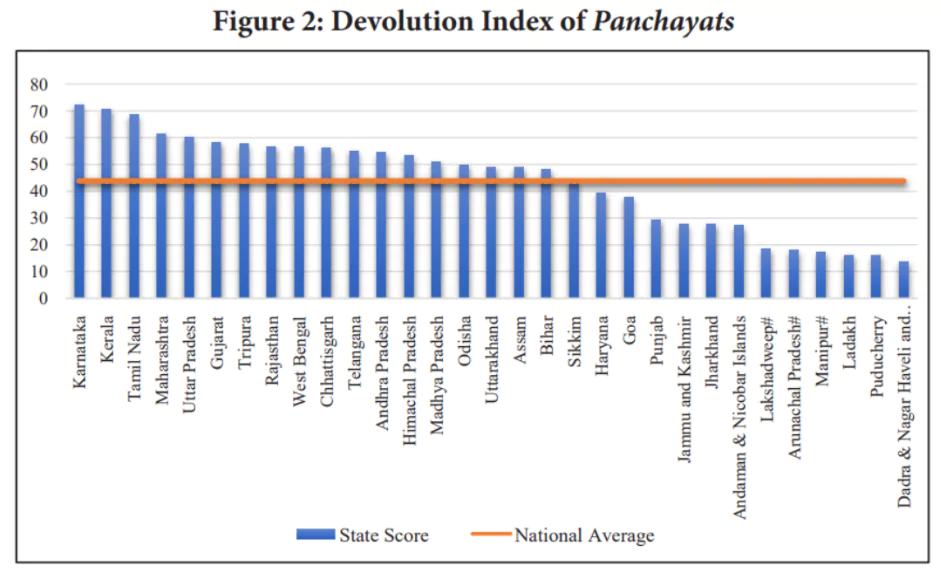The Ministry of Panchayati Raj has unveiled the report titled “Status of Devolution to Panchayats in States – An Indicative Evidence-Based Ranking”.
Meaning of Devolution
- Devolution refers to the transfer of financial resources, powers, and responsibilities from the central or state governments to the Panchayati Raj Institutions (PRIs).
- This process is aimed at empowering local self-governments to manage their own finances and make decisions related to local development and governance.
Importance of Devolution in Panchayat Finance
- Empowerment: Enhances the financial independence of Panchayats, enabling them to address local issues effectively.
- Local Development: Ensures that funds are used for projects that directly benefit the community.
- Democratic Governance: Promotes participatory decision-making and accountability at the grassroots level.
|
More about the Status of Devolution to Panchayats in States
- The report is prepared by Indian Institute of Public Administration (IIPA), New Delhi.
- It provides a comprehensive analysis of how well Panchayats are equipped to fulfill their constitutional roles in each State.
- It also highlights the gaps and challenges that need to be addressed for Panchayats to function as true institutions of local self-government.
Key Findings
- Increase in Devolution: Devolution to rural local bodies increased from 39.9% in 2013-14 to 43.9% in 2021-22.
- Significant improvements were seen in capacity enhancement (from 44% to 54.6%) and functionaries (from 39.6% to 50.9%).
- Top Performers: Karnataka topped the rankings, followed by Kerala and Tamil Nadu.
- Uttar Pradesh made remarkable progress, jumping from 15th to 5th position.
- Success Stories:
- Uttar Pradesh: Improved its accountability framework through transparency initiatives and anti-corruption measures.
- Tripura: Jumped from 13th to 7th position, excelling in revenue generation and fiscal management.
Devolution Index: State Rankings
- The report ranks states based on six dimensions of devolution:
- Top 10 States (DI Score > 55):
- Karnataka
- Kerala
- Tamil Nadu
- Maharashtra
- Uttar Pradesh
- Gujarat
- Tripura
- Rajasthan
- West Bengal
- Chhattisgarh
- Medium Performers (DI Score 50-55):
- Andhra Pradesh, Himachal Pradesh, Madhya Pradesh, and Odisha.

Six Dimensions of Devolution
- Framework: Kerala ranks first in establishing a robust constitutional framework for Panchayats.
- Functions: Tamil Nadu leads in functional devolution, ensuring Panchayats have clear roles and responsibilities.
- Finances: Karnataka excels in financial management, ensuring adequate funds for rural local bodies.
- Functionaries: Gujarat tops in personnel management and capacity building for Panchayats.
- Capacity Enhancement: Telangana leads in institutional strengthening and training for Panchayats.
- Accountability: Karnataka sets new standards in transparency and accountability.
Key Recommendations in the report
- Monitor Fund Utilization: There is a need to monitor funds devolved to rural local bodies to prevent corruption and financial irregularities.
- Empower Panchayats: Decisive steps are needed to empower Panchayats as centers of local governance.
- Expand Services: Panchayat Bhawans should serve as hubs for essential services like pensions, birth/death certificates, and access to central schemes like Ayushman Bharat.
Transformative Progress
- The report highlights the transformative progress in Panchayati Raj over the last decade, including:
- Digital transformation.
- Improved Panchayat infrastructure (offices, computers, internet connectivity).
- Regular Panchayat elections and enhanced accounting/audit systems.
Provisions Regarding Devolution of Finance to Panchayats in India
- Constitutional Provisions:
- Article 243H – Financial Powers of Panchayats: Empowers State Legislatures to authorize Panchayats to levy, collect, and appropriate taxes, duties, tolls, and fees.
- Provides grants-in-aid from the State government to Panchayats.
- Article 243-I – State Finance Commission (SFC): Mandates the establishment of a State Finance Commission (SFC) every five years.
- State Finance Commission recommends distribution of financial resources between State and Panchayats and allocation of taxes, duties, and fees collected by the State to Panchayats.
- (d) Article 280 – Finance Commission of India: Recommends grants-in-aid to States for the development of Panchayati Raj Institutions (PRIs).
- The 15th Finance Commission allocated Rs. 4.36 lakh crore (2021-26) for local bodies, including Panchayats.
- Statutory Provisions:
- Panchayati Raj Acts of States: Each State has its own Panchayati Raj Act, detailing financial devolution, taxation, and fund utilization.
- They define revenue sources such as property tax, profession tax, vehicle tax, market fees, user charges, and service fees.
|
Major concerns regarding devolution to Panchayats
- Limited Overall Devolution Progress: The increase in devolution from 39.9% to 43.9% over eight years (2013-14 to 2021-22), though positive, is relatively slow.
- Inter-State Disparities in Devolution: Some States like Karnataka, Kerala, and Tamil Nadu have made significant progress, whereas others continue to lag.
- Gaps in Functional Devolution: The functional devolution index (measuring the actual powers given to Panchayats) remains inconsistent across States.
- Tamil Nadu leads in functional devolution, but other States need to bridge this gap.
- Capacity Constraints and Institutional Strengthening: While initiatives like the Rashtriya Gram Swaraj Abhiyan (RGSA) have improved capacity enhancement, many Panchayats still lack trained personnel, digital infrastructure, and technical expertise to manage funds and execute development programs effectively.
- Telangana leads in capacity enhancement, but other States need to strengthen institutional support for Panchayats.
- Parallel Bodies Undermining Panchayats: Several states have parallel bodies whose functions overlap with those of Panchayats, reducing their decision-making power.
Conclusion
The report marks a significant milestone in India’s journey toward empowering Panchayati Raj Institutions (PRIs) and realizing the vision of Gram Swaraj (self-reliant village republics). It not only celebrates the achievements of high-performing states but also provides a roadmap for others to enhance their rural governance frameworks.
![]() 14 Feb 2025
14 Feb 2025


